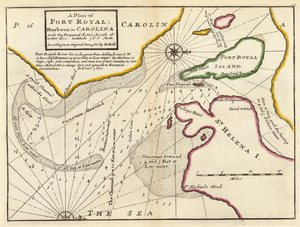Port Royal Sound facts for kids
Port Royal Sound is a large bay or inlet on the coast of South Carolina. It's where several rivers meet the Atlantic Ocean. The biggest river flowing into it is the Broad River. This area is known as an estuary, where fresh river water mixes with salty ocean water. It's located in Beaufort County, in a beautiful area called the Sea Islands.
Geography of Port Royal Sound
Port Royal Sound is surrounded by many islands. To the south is Hilton Head Island. To the north are Port Royal Island, Saint Helena Island, and Parris Island. There are also many other smaller islands nearby. Parris Island is famous for being a training base for the U.S. Marine Corps.
Several rivers flow into Port Royal Sound. The most important one is the Broad River. Other rivers include the Coosawhatchie River, Colleton River, Chechessee River, and Pocotaligo River.
Many waterways in the Sea Islands are like natural channels. They connect different bays and estuaries and separate the islands. Port Royal Sound is connected to other water bodies this way. For example, the Beaufort River separates Port Royal Island from St. Helena Island. It links Port Royal Sound to Saint Helena Sound. Skull Creek and Mackay Creek separate Hilton Head Island from the mainland. They connect Port Royal Sound to Calibogue Sound. Another waterway, Whale Branch, separates Port Royal Island from the mainland. It connects Port Royal Sound and the Broad River to Saint Helena Sound.
The town of Port Royal and the city of Beaufort are both located on Port Royal Island. The Intracoastal Waterway, a famous water highway, also passes through Port Royal Sound.
History of Port Royal Sound
Spanish explorers likely visited Port Royal Sound first. This happened in 1521 and 1526, led by Lucas Vázquez de Ayllón. However, their exact routes are still debated by historians.
The name "Port Royal Sound" was given in 1562 by Jean Ribault. He was a French explorer who started a short-lived colony called Charlesfort on Parris Island. This colony was for Huguenots, who were French Protestants. This makes Port Royal Sound the second oldest French place-name still used in the U.S. In 1566, Pedro Menéndez de Avilés founded a Spanish settlement called Santa Elena in the area. It was an important Spanish colony until about 1587.
In 1663, the Province of Carolina was founded by the British. While Charles Town became the main city, the Port Royal Sound area was very important. It was key for both defense and trade from the very beginning of the colony.
In 1684, about 150 Scottish immigrants started a town called Stuarts Town near Port Royal Sound. These colonists encouraged the Yamasee Indians to raid Spanish lands. In response, the Spanish attacked and destroyed Stuarts Town in 1686.
Port Royal was one of the first British settlements in South Carolina. The town of Beaufort was founded around 1710. It became the main settlement on Port Royal Island.
The Yamasee Indians were important allies for South Carolina from about 1685 to 1715. They were a group of different tribes, including the Guale and Tama. They had been allies and enemies of both the Spanish and British over time. By 1710, the Yamasee had settled in about ten towns around Port Royal. Some of their town names are still used today, like Altamaha, Chechessee, Pocotaligo, and Huspah. Relations with South Carolina worsened in the early 1700s. After the Yamasee War in 1715, many Yamasee and other local Indians moved south. Most became allies of the Spanish. This left South Carolina's southern border unprotected. This led to building new forts and the creation of the new colony of Georgia.
Fort Frederick was built on Port Royal Island in the 1730s. Today, you can still see its remains at the Fort Frederick Heritage Preserve.
During the American Civil War, Union naval commander Samuel Francis Du Pont captured the forts protecting Port Royal Sound. The Union controlled the sound for the rest of the war. It became a major naval base for them.
Fort Fremont was a coastal defense fort on St. Helena Island. It was built between 1899 and 1921 to protect the coast.
The USGS says that Port Royal Sound has had other names in the past. These include Brayne Sound, Winneau River, Weenea River, Portus Regalis, Port Royal River, and Port Royal Entrance.


